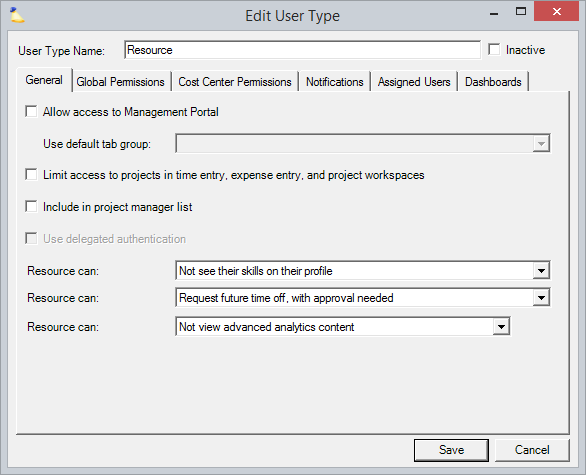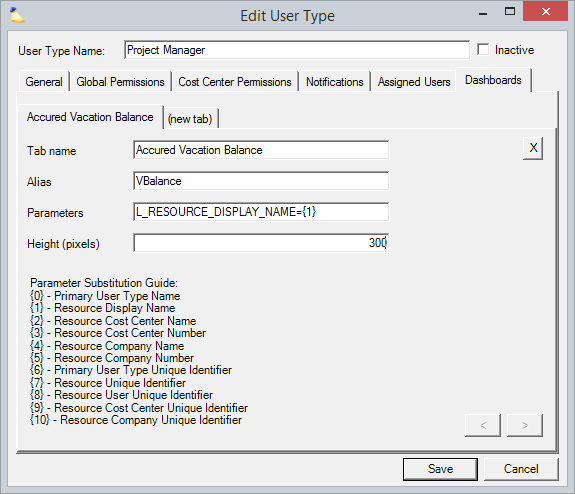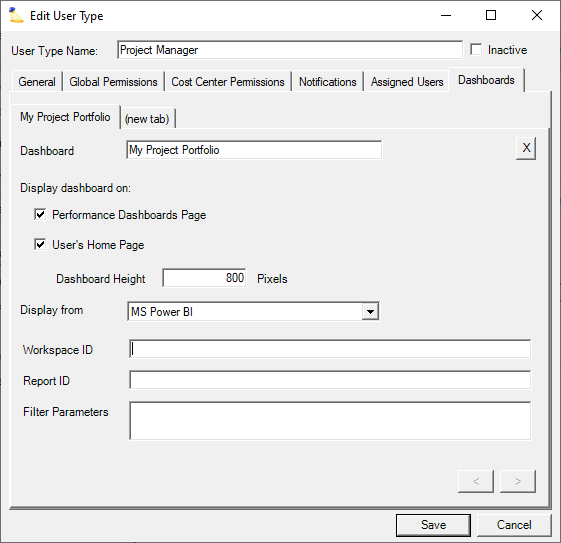...
...
| Excerpt | ||
|---|---|---|
| ||
define access rules, permissions, and notifications to groups of users |
...
General permissions are either on or off and govern access to a few major areas of Projector. Please see this page for a full explanation of each permission.
Global Permissions Tab
Global Permissions are used to control access to features which affect the entire system. They are divided into none, view and update. For an explanation of each line-item, see Global Permissions.
...
Display up to five custom business intelligence tables and charts on a user's My Home Page or Performance Dashboards. The dashboards shown to a user come from their Primary User Type. If a user has multiple user types, they do not get to see additional dashboards. Dashboards are commonly used to show things like:
- Accrued vacation
- Utilization
- Company performance metrics
- Personal performance metrics
This tab is only editable if you have the Advanced Analytics module enabled.
| Tip | ||
|---|---|---|
| ||
Your installation comes with five example dashboards as shown in ProjectorBI Base Home Page Dashboards. You can define your own or edit the base ones as a starting point. |
...
Users can only see the dashboards if they are also provisioned in |
...
ProjectorBI. Once provisioned in |
...
ProjectorBI, users do not need dashboards, reports, or data sets shared to them. The only thing required to view a project dashboard is to ensure it has been published (see alias in table below). Or you may want to review the ProjectorBI Initial Configuration |
...
guide. |
| Control | Description | |
|---|---|---|
| Dashboard | Tab Name | When users view their my home page they will see a drop down box. The box contains a list of each tab defined on this screen. The names in that list are driven by the Tab NameName your dashboard. Users will see this name from their home page or performance dashboards. |
| Alias | To display an AAM dashboard, the dashboard's alias must match the value entered here. To assign an alias to a dashboard -
When a dashboard has an alias, it does not need to be explicitly shared to a user for viewing. Think of an alias as a way of publishing a dashboard to anyone viewing it via My Home Page. | |
| Parameters | Parameters are used to filter a dashboard down to show specific data. The most common use case is to have a dashboard that shows data about many users, but when viewed via My Home Page it only contains data about the current user. To accommodate this, the following special short codes are supported.
Parameter filters only work if they are perfectly matched to a filter defined in AAM. To add a filter in AAM. See the My Home Page of ProjectorBI Initial Configuration for instructions setting this up. You are actually building a querystring here, so you can define multiple filters by using the "&" symbol. For example, Resource={1}&ResourceManager=Tom You can also filter using attribute codes. For example, L_DISPLAY_NAME={0}, but we discourage this method because you may have reports that don't necessarily need to filter based on project code. Or you may have joined data sets and the attribute codes may not be unique across reports. For example, L_DISPLAY_NAMEor L_DISPLAY_NAME_1.. |
...


